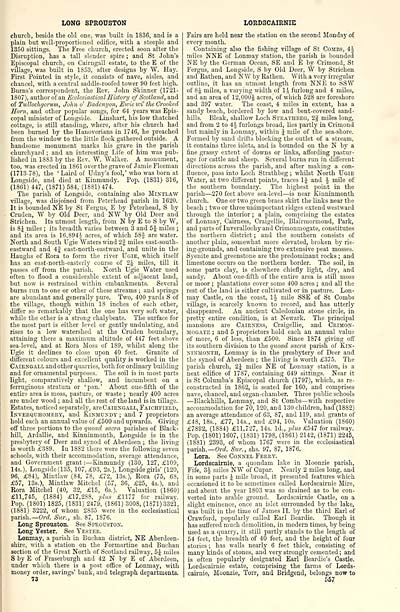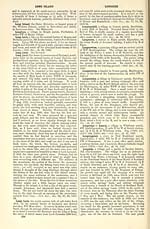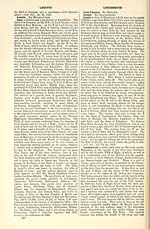Ordnance gazetteer of Scotland > Volume 5
(77) Page 557 - LON
Download files
Complete book:
Individual page:
Thumbnail gallery: Grid view | List view

LONG SPROUSTON
LORDSCAIENIE
church, beside the old one, was built in 1836, and is a
plain but well-proportioned edifice, with a steeple and
1350 sittings. The Free church, erected soon after the
Disruption, has a tall slender spire ; and St John's
Episcopal church, on Cairngall estate, to the E of the
village, was built in 1853, after designs by W. Hay.
First Pointed in style, it consists of nave, aisles, and
chancel, with a central saddle-roofed tower 90 feet high.
Burns's correspondent, the Rev. John Skinner (1721-
1807), authorofan Ecclesiastical History of Scotlaml, and
of Tidlochgorum, John o' Badcnyon, Eioie wi' tJie Crooked
Horn, and other popular songs, for 64 years was Epis-
copal minister of Longside. Liushart, his low thatched
cottage, is still standing, where, after his church had
been burned by the Hanoverians in 1746, he preached
from the window to the little flock gathered outside. A
handsome monument marks his grave in the parish
churchyard ; and an interesting Life of him was pub-
lished in 1883 by the Key. W. Walker. A monument,
too, was erected in 1861 over the grave of Jamie Fleeman
(1713-78), the ' Laird of Udny's fool,' who was born at
Longside, and died at Kinmundy. Pop. (1831) 316,
(1861) 447, (1871) 584, (1881) 474.
The parish of Longside, containing also Mintlaw
village, was disjoined from Peterhead parish in 1620.
It is bounded NE by St Fergus, E by Peterhead, S by
Cruden, W by Old Deer, and NW by Old Deer and
Strichen. Its utmost length, from N by E to S by W,
is 8^ miles ; its breadth varies between 3 and 5J miles ;
and its area is 16,S94J acres, of which 58|- are water.
North and South Ugie Waters wind 2| miles east-south-
eastward and 4 j east-north-eastward, and unite in the
Haughs of Eora to form the river Ugie, which itself
has an east-north-easterly course of 2J miles, till it
passes off from the parish. North Ugie Water used
often to flood a considerable extent of adjacent land,
but now is restrained within embankments. Several
burns run to one or other of these streams ; and springs
are abundant and generally pure. Two, 400 yards S of
the village, though within 18 inches of each other,
differ so remarkablj' that the one has very soft water,
while the other is a strong chalybeate. The surface for
the most part is either level or gently undulating, and
rises to a low watershed at the Cruden boundary,
attaining there a maximum altitude of 447 feet above
sea-level, and at Eora Moss of 189, whilst along the
Ugie it declines to close upon 40 feet. Granite of
different colours and excellent quality is worked in the
Cairngall and other quarries, both for ordinary building
and for ornamental purposes. The soil is in most parts
light, comparatively shallow, and incumbent on a
ferruginous stratum or 'pan.' About one-fifth of the
entire area is moss, pasture, or waste ; nearly 400 acres
are under wood ; and all the rest of the land is in tillage.
Estates, noticed separately, are Cairngall, Faichfibld,
Inverquhomert, and Kinmundy ; and 7 proprietors
hold each an annual value of £500 and upwards. Giving
off three portions to the quoad sacra parishes of Black-
hill, ArdaUie, and Kinninmonth, Longside is in the
presbytery of Deer and synod of Aberdeen ; the living
is worth £389. In 1882 there were the following seven
schools, with their accommodation, average attendance,
and Government grant : — Kinmundy (130, 127, £109,
14s.), Longside (135, 107, £93, 2s.), Longside girls' (120,
96, £84), Mintlaw (84, 78, £72, 13s.),' Kora (75, 68,
£57, 13s.), Mintlaw Mitchel (57, 36, £25, 4s.), and
Eora Mitchel (40, 32, £15, 6s.). A^aluation (1860)
£11,745, (1884) £17,288, p?i«s £1177 for railway.
Pop. (1801) 1825, (1831) 2479, (1861) 3008, (1871)3321,
(1881) 3222, of whom 2835 were in the ecclesiastical
parish. — 07-d. Sur., sh. 87, 1876.
Long Sprouston. See SpEOtrsTOX.
Long Yester. See Yester.
Lomnay, a parish in Buchan district, NE Aberdeen-
shire, witli a station on the Formartine and Buchan
section of the Great North of Scotland railway, 5^ miles
S by E of Fraserburgh and 42 N by E of Aberdeen,
under which there is a post office of Lonmay, -with
money order, savings' bank, and telegraph departments.
73
Fairs are held near the station on the second Monday of
every month.
Containing also the fishing village of St Combs, 4i
miles NNE of Lonmay station, the parish is bounded
NE by the German Ocean, SE and E by Crimond, St
Fergus, and Longside, S by Old Deer, W by Strichen
and Rathen, and NW by Ratheu. With a very irregular
outline, it has an utmost length from NNE to SSW
of 8J miles, a varying width of 1;^ furlong and 4 miles,
and an area of 12,000J acres, of which 528 are foreshore
and 397 water. The coast, 4 miles in extent, has a
sandy beach, bordered by low and bent-covered sand-
hills. Bleak, shallow Loch Stuatiibeg, 2§ miles long,
and from 2 to 4J furlongs broad, lies partly in Crimond
but mainly in Lonmay, within j mile of the sea-shore.
Formed by sand drifts blocking the outlet of a stream,
it contains three islets, and is bounded on the N by a
fine grassy extent of downs or links, affording pastur-
age for cattle and sheep. Several burns run in difi'erent
directions across the parish, and after making a con-
fluence, pass into Loch Strathbeg ; whilst North Ugie
Water, at two diS'erent points, traces IJ and ^ mile of
the southern boundary. The highest point in the
parish — 270 feet above sea-level — is near Kinninmonth
church. One or two green braes skirt the links near the
beach ; two or three unimportant ridges extend westward
through the interior ; a plain, comprising the estates
of Lonmay, Cairness, Craigellie, Blairraormond, Park,
and parts of Inverallochy and Crimonmogate, constitutes
the northern district ; and the southern consists of
another plain, somewhat more elevated, broken by ris-
ing-grounds, and containing two extensive peat mosses.
Syenite and greenstone are the predominant rocks ; and
limestone occurs on the northern border. The soil, in
some parts clay, is elsewhere chiefly light, dry, and
sandy. About one-fifth of the entire area is still moss
or moor ; plantations cover some 400 acres ; and all the
rest of the land is either cultivated or in pasture. Lon-
may Castle, on the coast, 1-i mile SSE of St Combs
village, is scarcely known to record, and has utterly
disappeared. An ancient Caledonian stone circle, in
pretty entire condition, is at Newark. The principal
mansions are Cairness, Craigellie, and Crimon-
mogate ; and 5 proprietors hold each an annual value
of more, 6 of less, than £500. Since 1874 giving off
its southern division to the quoad sacra parish of Kin-
ninmonth, Lonmay is in the presbytery of Deer and
the synod of Aberdeen ; the living is worth £375. The
parish church, 2J miles NE of Lonmay station, is a
neat edifice of 1787, containing 649 sittings. Near it
is St Columba's Episcopal church (1797), which, as re-
constructed in 1862, is seated for 160, and comprises
nave, chancel, and organ-chamber. Three public schools
— Blackhills, Lonmay, and St Combs — with respective
accommodation for 70, 120, and 130 children, had (1882)
an average attendance of 63, 87, and 119, and grants of
£48, 18s., £77, 14s., and £94, 10s. Valuation (1860)
£7892, (1884) £11,727, 14s. Id., plus £547 for railway.
Pop. (1801)1607, (1831) 1798, (1861) 2142, (1871) 2245,
(1881) 2393, of whom 1767 were in the ecclesiastical
parish.— Orrf. Sur., shs. 97, 87, 1876.
Lora. See Connel Ferry.
Lordscaimie, a quondam lake in Moonzie parish,
Fife, 3J miles NW of Cupar. Nearly 2 miles long, and
in some parts J mile broad, it presented features which
occasioned it to be sometimes called Lordscairnie Mire,
and about the year 1803 was so drained as to be con-
verted into arable ground. Lordscaii'nie Castle, on a
slight eminence, once an islet surrounded by the lake,
was built in the time of James II. by the third Earl of
Crawford, popularly called Earl Beardie. Though it
has suffered much demolition, in modern times, by being
used as a quarry, it still partly stands to the length of
54 feet, the breadth of 40 feet, and the height of four
stories ; has walls nearly 6 feet thick, consisting of
many kinds of stones, and very strongly cemented ; and
is often popularly designated Earl Beardie's Castle.
Lordscairnie estate, comprising the farms of Lords-
cairnie, Moonzie, Torr, and Bridgend, belongs now to
557
LORDSCAIENIE
church, beside the old one, was built in 1836, and is a
plain but well-proportioned edifice, with a steeple and
1350 sittings. The Free church, erected soon after the
Disruption, has a tall slender spire ; and St John's
Episcopal church, on Cairngall estate, to the E of the
village, was built in 1853, after designs by W. Hay.
First Pointed in style, it consists of nave, aisles, and
chancel, with a central saddle-roofed tower 90 feet high.
Burns's correspondent, the Rev. John Skinner (1721-
1807), authorofan Ecclesiastical History of Scotlaml, and
of Tidlochgorum, John o' Badcnyon, Eioie wi' tJie Crooked
Horn, and other popular songs, for 64 years was Epis-
copal minister of Longside. Liushart, his low thatched
cottage, is still standing, where, after his church had
been burned by the Hanoverians in 1746, he preached
from the window to the little flock gathered outside. A
handsome monument marks his grave in the parish
churchyard ; and an interesting Life of him was pub-
lished in 1883 by the Key. W. Walker. A monument,
too, was erected in 1861 over the grave of Jamie Fleeman
(1713-78), the ' Laird of Udny's fool,' who was born at
Longside, and died at Kinmundy. Pop. (1831) 316,
(1861) 447, (1871) 584, (1881) 474.
The parish of Longside, containing also Mintlaw
village, was disjoined from Peterhead parish in 1620.
It is bounded NE by St Fergus, E by Peterhead, S by
Cruden, W by Old Deer, and NW by Old Deer and
Strichen. Its utmost length, from N by E to S by W,
is 8^ miles ; its breadth varies between 3 and 5J miles ;
and its area is 16,S94J acres, of which 58|- are water.
North and South Ugie Waters wind 2| miles east-south-
eastward and 4 j east-north-eastward, and unite in the
Haughs of Eora to form the river Ugie, which itself
has an east-north-easterly course of 2J miles, till it
passes off from the parish. North Ugie Water used
often to flood a considerable extent of adjacent land,
but now is restrained within embankments. Several
burns run to one or other of these streams ; and springs
are abundant and generally pure. Two, 400 yards S of
the village, though within 18 inches of each other,
differ so remarkablj' that the one has very soft water,
while the other is a strong chalybeate. The surface for
the most part is either level or gently undulating, and
rises to a low watershed at the Cruden boundary,
attaining there a maximum altitude of 447 feet above
sea-level, and at Eora Moss of 189, whilst along the
Ugie it declines to close upon 40 feet. Granite of
different colours and excellent quality is worked in the
Cairngall and other quarries, both for ordinary building
and for ornamental purposes. The soil is in most parts
light, comparatively shallow, and incumbent on a
ferruginous stratum or 'pan.' About one-fifth of the
entire area is moss, pasture, or waste ; nearly 400 acres
are under wood ; and all the rest of the land is in tillage.
Estates, noticed separately, are Cairngall, Faichfibld,
Inverquhomert, and Kinmundy ; and 7 proprietors
hold each an annual value of £500 and upwards. Giving
off three portions to the quoad sacra parishes of Black-
hill, ArdaUie, and Kinninmonth, Longside is in the
presbytery of Deer and synod of Aberdeen ; the living
is worth £389. In 1882 there were the following seven
schools, with their accommodation, average attendance,
and Government grant : — Kinmundy (130, 127, £109,
14s.), Longside (135, 107, £93, 2s.), Longside girls' (120,
96, £84), Mintlaw (84, 78, £72, 13s.),' Kora (75, 68,
£57, 13s.), Mintlaw Mitchel (57, 36, £25, 4s.), and
Eora Mitchel (40, 32, £15, 6s.). A^aluation (1860)
£11,745, (1884) £17,288, p?i«s £1177 for railway.
Pop. (1801) 1825, (1831) 2479, (1861) 3008, (1871)3321,
(1881) 3222, of whom 2835 were in the ecclesiastical
parish. — 07-d. Sur., sh. 87, 1876.
Long Sprouston. See SpEOtrsTOX.
Long Yester. See Yester.
Lomnay, a parish in Buchan district, NE Aberdeen-
shire, witli a station on the Formartine and Buchan
section of the Great North of Scotland railway, 5^ miles
S by E of Fraserburgh and 42 N by E of Aberdeen,
under which there is a post office of Lonmay, -with
money order, savings' bank, and telegraph departments.
73
Fairs are held near the station on the second Monday of
every month.
Containing also the fishing village of St Combs, 4i
miles NNE of Lonmay station, the parish is bounded
NE by the German Ocean, SE and E by Crimond, St
Fergus, and Longside, S by Old Deer, W by Strichen
and Rathen, and NW by Ratheu. With a very irregular
outline, it has an utmost length from NNE to SSW
of 8J miles, a varying width of 1;^ furlong and 4 miles,
and an area of 12,000J acres, of which 528 are foreshore
and 397 water. The coast, 4 miles in extent, has a
sandy beach, bordered by low and bent-covered sand-
hills. Bleak, shallow Loch Stuatiibeg, 2§ miles long,
and from 2 to 4J furlongs broad, lies partly in Crimond
but mainly in Lonmay, within j mile of the sea-shore.
Formed by sand drifts blocking the outlet of a stream,
it contains three islets, and is bounded on the N by a
fine grassy extent of downs or links, affording pastur-
age for cattle and sheep. Several burns run in difi'erent
directions across the parish, and after making a con-
fluence, pass into Loch Strathbeg ; whilst North Ugie
Water, at two diS'erent points, traces IJ and ^ mile of
the southern boundary. The highest point in the
parish — 270 feet above sea-level — is near Kinninmonth
church. One or two green braes skirt the links near the
beach ; two or three unimportant ridges extend westward
through the interior ; a plain, comprising the estates
of Lonmay, Cairness, Craigellie, Blairraormond, Park,
and parts of Inverallochy and Crimonmogate, constitutes
the northern district ; and the southern consists of
another plain, somewhat more elevated, broken by ris-
ing-grounds, and containing two extensive peat mosses.
Syenite and greenstone are the predominant rocks ; and
limestone occurs on the northern border. The soil, in
some parts clay, is elsewhere chiefly light, dry, and
sandy. About one-fifth of the entire area is still moss
or moor ; plantations cover some 400 acres ; and all the
rest of the land is either cultivated or in pasture. Lon-
may Castle, on the coast, 1-i mile SSE of St Combs
village, is scarcely known to record, and has utterly
disappeared. An ancient Caledonian stone circle, in
pretty entire condition, is at Newark. The principal
mansions are Cairness, Craigellie, and Crimon-
mogate ; and 5 proprietors hold each an annual value
of more, 6 of less, than £500. Since 1874 giving off
its southern division to the quoad sacra parish of Kin-
ninmonth, Lonmay is in the presbytery of Deer and
the synod of Aberdeen ; the living is worth £375. The
parish church, 2J miles NE of Lonmay station, is a
neat edifice of 1787, containing 649 sittings. Near it
is St Columba's Episcopal church (1797), which, as re-
constructed in 1862, is seated for 160, and comprises
nave, chancel, and organ-chamber. Three public schools
— Blackhills, Lonmay, and St Combs — with respective
accommodation for 70, 120, and 130 children, had (1882)
an average attendance of 63, 87, and 119, and grants of
£48, 18s., £77, 14s., and £94, 10s. Valuation (1860)
£7892, (1884) £11,727, 14s. Id., plus £547 for railway.
Pop. (1801)1607, (1831) 1798, (1861) 2142, (1871) 2245,
(1881) 2393, of whom 1767 were in the ecclesiastical
parish.— Orrf. Sur., shs. 97, 87, 1876.
Lora. See Connel Ferry.
Lordscaimie, a quondam lake in Moonzie parish,
Fife, 3J miles NW of Cupar. Nearly 2 miles long, and
in some parts J mile broad, it presented features which
occasioned it to be sometimes called Lordscairnie Mire,
and about the year 1803 was so drained as to be con-
verted into arable ground. Lordscaii'nie Castle, on a
slight eminence, once an islet surrounded by the lake,
was built in the time of James II. by the third Earl of
Crawford, popularly called Earl Beardie. Though it
has suffered much demolition, in modern times, by being
used as a quarry, it still partly stands to the length of
54 feet, the breadth of 40 feet, and the height of four
stories ; has walls nearly 6 feet thick, consisting of
many kinds of stones, and very strongly cemented ; and
is often popularly designated Earl Beardie's Castle.
Lordscairnie estate, comprising the farms of Lords-
cairnie, Moonzie, Torr, and Bridgend, belongs now to
557
Set display mode to: Large image | Transcription
Images and transcriptions on this page, including medium image downloads, may be used under the Creative Commons Attribution 4.0 International Licence unless otherwise stated. ![]()
| Gazetteers of Scotland, 1803-1901 > Ordnance gazetteer of Scotland > Volume 5 > (77) Page 557 - LON |
|---|
| Permanent URL | https://digital.nls.uk/97384874 |
|---|
| Attribution and copyright: |
|
|---|---|

